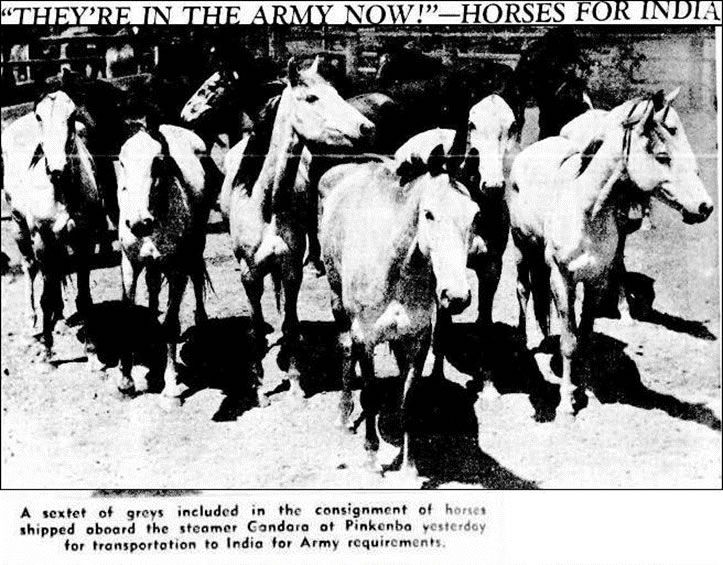Some Waler History

© Janet Lane. All rights reserved. Image: Courier Mail, October 1936.
The name Waler is derived from New South Waler – meaning a horse bred in NSW, as the colony was first referred to. It was coined as a term for horses sent overseas for remounts for the British armies in China and India, and for Indian regiments. Rajahs as well as the English in India bought Waler ponies for polo. The remount trade flourished from the 1840s to the 1930s. Australia used Walers for stock horses, harness horses and general use, as well as for the Artillery and Light Horse in the Boer War and World War One. Many Northern Territory and South Australian stations were leased solely for the purposes of horse breeding. The name Waler soon became a term for a strong type of horse as they became widely used within Australia as well as for the India trade.
When the Boer War and World War One came around, Australia could instantly horse its mounted divisions – because there was a ready-made supply, in great numbers, of the perfect cavalry horse – the Waler, which breeders had been supplying India with, as well as stockmen, coach-teams, wool and wheat wagons. The type was perfected and running on many large stations which made their living from the sale of these horses. It was the Australian army which made legends of these horses, and you only needed to speak to any old light-horseman to see how very attached they were to their faithful mounts.
Although we didn’t send horses directly to the UK (just a random few), their army got a lot from India. Regiments were sent to India unhorsed and returned horsed. As well, officers often took favorites home – carriage horses, hunters etc. These were invariably Australian horses. I have a horse magazine article, which interviews a retired English cavalryman; he spent his life in the service. There’s a telling quote: “Our troop horses, issued by the government, were almost all Australian Walers. That’s a horse like a heavy hunter.” He was talking about training in England. From: Classic (an American magazine published in New York) Aug-Sept 1977, article “Before the Charging Stopped” by Gene Smith about English mounted regiments and in particular Derek Howard Douglas, born 1913, of the 18th Hussars (went to Egypt, India etc with them), then H.M. First Royal Dragoons. I was once sent a photo of two English soldiers, taken about WWII (?) in England standing by their very solid horses, and was asked were they Walers, I was unable to answer with any certainty, although I saw an article in a book once (will dig it out one day!) that said English hunters owed their heaviness and good nature to Walers brought in for the cavalry, at a time it was hard to find a heavy horse in England.
The India trade is what created the demand for remounts in large numbers. The first big mob of some 5,000 horses, were taken to central Australia for breeding for this trade by Tennant and Love, in the 1870’s. They went to Undoolya Station (next door to the Garden Station) near Alice Springs, from the Eyre Peninsula – many of these horses were from Horse Peninsula (now Coffin Bay) where a lot of Timor Ponies had been released. The descendants of those ponies left behind are today’s Coffin Bay Ponies. Our Central Australian Walers would have the blood of Tennant and Love’s first horses in the area, and very likely some from the Thoroughbreds Tennant later bred.
Many horse breeders and buyers were famous in Association, and in the horse world. The Tennants, as their fortunes improved, became involved with horse-racing and Thoroughbred breeding in South Australia, and hunted.
Some central Australian horse breeders were Sir Sid Kidman, Tennant and Love, the Robbs and the Barkers. Licensed exporters to India, who attended Kidman’s huge yearly horse sales at Kapunda in S.A. were the dapper “Colonel” Steve Margrett, J.E. Robb, R. McKenna and Son, A. Glasscock and Son, and W.A. Jones Pty Ltd who all shipped to Bombay. Licensed dealers who shipped to Calcutta were Bob and Theo Gove, and the Baldocks. Others were H. Davis and Co (formerly the Lyons Bros.), Alan McPherson (who took over J.S. Love’s business), and Bob and Curtis Skene who bought polo ponies for the State of Kashmir. Well known horse dealers who did not export, but traded within Australia including to Western Australia were George Medlow and Sam Rasheed.
Kidman’s annual horse sales went on for two weeks; a horse was auctioned every two minutes of the long days. Thousands. A good book on Sid Kidman will give you more details. The book The Cattle King by Ion Idriess is good on properties but not much for horse info; Jill Bowen’s book Kidman The Forgotten King is very useful. Newspapers of the times have sales details too. Kidman owned more land than anyone in the world in his heyday, over 100,000 square miles. South Australian Parliamentary Papers from the 1800’s and 1900’s are good records to find research on horse breeding stations, and government requirements for the India trade.
You can look history up in books and records yourself, so I won’t go into exhaustive detail here regarding early days, the British in India, the Light Horse and so on. It’s important to have a working knowledge of the breeds that went into the Waler. You can then recognise ancestral influence. It’s part of the history as much as knowing when the charge at Beersheba took place, or where King George V got his beloved Waler Rupert. It’s what made our horses what they are today.